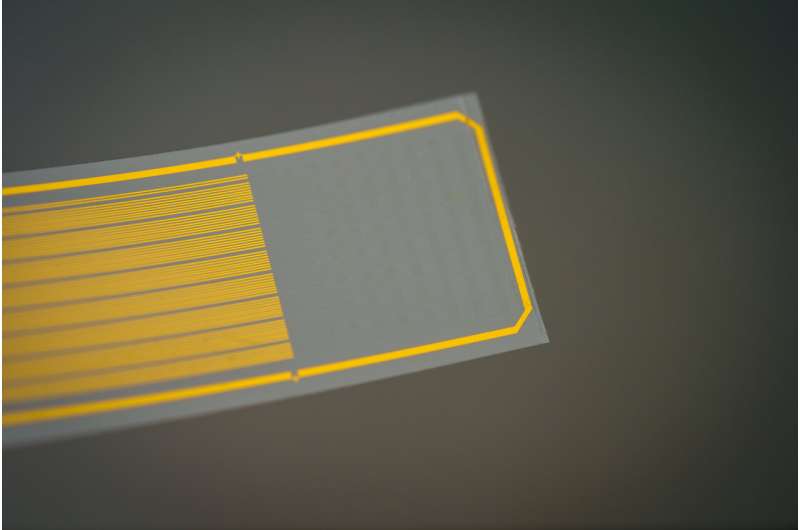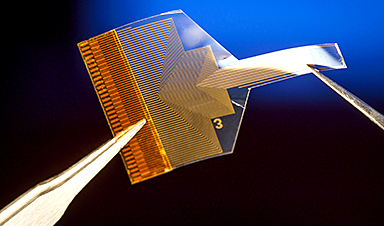Researchers at the University of California San Diego have developed a neural implant that provides information about activity deep inside the brain while sitting on its surface. The implant is made up of a thin, transparent and flexible polymer strip that is packed with a dense array of graphene electrodes. The technology, tested in transgenic mice, brings the researchers a step closer to building a minimally invasive brain-computer interface (BCI) that provides high-resolution data about deep neural activity by using recordings from the brain surface.
“We are expanding the spatial reach of neural recordings with this technology,” said study senior author Duygu Kuzum, a professor in the Department of Electrical and Computer Engineering at the UC San Diego Jacobs School of Engineering. “Even though our implant resides on the brain’s surface, its design goes beyond the limits of physical sensing in that it can infer neural activity from deeper layers.”
This work overcomes the limitations of current neural implant technologies. Existing surface arrays, for example, are minimally invasive, but they lack the ability to capture information beyond the brain’s outer layers. In contrast, electrode arrays with thin needles that penetrate the brain are capable of probing deeper layers, but they often lead to inflammation and scarring, compromising signal quality over time.
The new neural implant developed at UC San Diego offers the best of both worlds.
The implant is a thin, transparent and flexible polymer strip that conforms to the brain’s surface. The strip is embedded with a high-density array of tiny, circular graphene electrodes, each measuring 20 micrometers in diameter. Each electrode is connected by a micrometers-thin graphene wire to a circuit board.
In tests on transgenic mice, the implant enabled the researchers to capture high-resolution information about two types of neural activity—electrical activity and calcium activity—at the same time. When placed on the surface of the brain, the implant recorded electrical signals from neurons in the outer layers. At the same time, the researchers used a two-photon microscope to shine laser light through the implant to image calcium spikes from neurons located as deep as 250 micrometers below the surface.
The researchers found a correlation between surface electrical signals and calcium spikes in deeper layers. This correlation enabled the researchers to use surface electrical signals to train neural networks to predict calcium activity—not only for large populations of neurons, but also individual neurons—at various depths.
“The neural network model is trained to learn the relationship between the surface electrical recordings and the calcium ion activity of the neurons at depth,” said Kuzum. “Once it learns that relationship, we can use the model to predict the depth activity from the surface.”
An advantage of being able to predict calcium activity from electrical signals is that it overcomes the limitations of imaging experiments. When imaging calcium spikes, the subject’s head must be fixed under a microscope. Also, these experiments can only last for an hour or two at a time.
“Since electrical recordings do not have these limitations, our technology makes it possible to conduct longer duration experiments in which the subject is free to move around and perform complex behavioral tasks,” said study co-first author Mehrdad Ramezani, an electrical and computer engineering Ph.D. student in Kuzum’s lab. “This can provide a more comprehensive understanding of neural activity in dynamic, real-world scenarios.”
Designing and fabricating the neural implant
The technology owes its success to several innovative design features: transparency and high electrode density combined with machine learning methods.
“This new generation of transparent graphene electrodes embedded at high density enables us to sample neural activity with higher spatial resolution,” said Kuzum. “As a result, the quality of signals improves significantly. What makes this technology even more remarkable is the integration of machine learning methods, which make it possible to predict deep neural activity from surface signals.”

This study was a collaborative effort among multiple research groups at UC San Diego. The team, led by Kuzum, who specializes in developing multimodal neural interfaces, includes nanoengineering professor Ertugrul Cubukcu, who specializes in advanced micro- and nanofabrication techniques for graphene materials; electrical and computer engineering professor Vikash Gilja, whose lab integrates domain-specific knowledge from the fields of basic neuroscience, signal processing, and machine learning to decode neural signals; and neurobiology and neurosciences professor Takaki Komiyama, whose lab focuses on investigating neural circuit mechanisms that underlie flexible behaviors.
Transparency is one of the key features of this neural implant. Traditional implants use opaque metal materials for their electrodes and wires, which block the view of neurons beneath the electrodes during imaging experiments. In contrast, an implant made using graphene is transparent, which provides a completely clear field of view for a microscope during imaging experiments.
“Seamless integration of recording electrical signals and optical imaging of the neural activity at the same time is only possible with this technology,” said Kuzum. “Being able to conduct both experiments at the same time gives us more relevant data because we can see how the imaging experiments are time-coupled to the electrical recordings.”
To make the implant completely transparent, the researchers used super thin, long graphene wires instead of traditional metal wires to connect the electrodes to the circuit board. However, fabricating a single layer of graphene as a thin, long wire is challenging because any defect will render the wire nonfunctional, explained Ramezani. “There may be a gap in the graphene wire that prevents the electrical signal from flowing through, so you basically end up with a broken wire.”
The researchers addressed this issue using a clever technique. Instead of fabricating the wires as a single layer of graphene, they fabricated them as a double layer doped with nitric acid in the middle.
“By having two layers of graphene on top of one another, there’s a good chance that defects in one layer will be masked by the other layer, ensuring the creation of fully functional, thin and long graphene wires with improved conductivity,” said Ramezani.
According to the researchers, this study demonstrates the most densely packed transparent electrode array on a surface-sitting neural implant to date. Achieving high density required fabricating extremely small graphene electrodes. This presented a considerable challenge, as shrinking graphene electrodes in size increases their impedance—this hinders the flow of electrical current needed for recording neural activity.
To overcome this obstacle, the researchers used a microfabrication technique developed by Kuzum’s lab that involves depositing platinum nanoparticles onto the graphene electrodes. This approach significantly improved electron flow through the electrodes while keeping them tiny and transparent.
Next steps
The team will next focus on testing the technology in different animal models, with the ultimate goal of human translation in the future.
Kuzum’s research group is also dedicated to using the technology to advance fundamental neuroscience research. In that spirit, they are sharing the technology with labs across the U.S. and Europe, contributing to diverse studies ranging from understanding how vascular activity is coupled to electrical activity in the brain to investigating how place cells in the brain are so efficient at creating spatial memory.
“This technology can be used for so many different fundamental neuroscience investigations, and we are eager to do our part to accelerate progress in better understanding the human brain,” said Kuzum.
More information: High-density Transparent Graphene Arrays for Predicting Cellular Calcium Activity at Depth from Surface Potential Recordings, Nature Nanotechnology (2024). DOI: 10.1038/s41565-023-01576-z
Journal information: Nature Nanotechnology
News
Team finds flawed data in recent study relevant to coronavirus antiviral development
The COVID pandemic illustrated how urgently we need antiviral medications capable of treating coronavirus infections. To aid this effort, researchers quickly homed in on part of SARS-CoV-2's molecular structure known as the NiRAN domain—an [...]
Drug-Coated Neural Implants Reduce Immune Rejection
Summary: A new study shows that coating neural prosthetic implants with the anti-inflammatory drug dexamethasone helps reduce the body’s immune response and scar tissue formation. This strategy enhances the long-term performance and stability of electrodes [...]
Scientists discover cancer-fighting bacteria that ‘soak up’ forever chemicals in the body
A family of healthy bacteria may help 'soak up' toxic forever chemicals in the body, warding off their cancerous effects. Forever chemicals, also known as PFAS (per- and polyfluoroalkyl substances), are toxic chemicals that [...]
Johns Hopkins Researchers Uncover a New Way To Kill Cancer Cells
A new study reveals that blocking ribosomal RNA production rewires cancer cell behavior and could help treat genetically unstable tumors. Researchers at the Johns Hopkins Kimmel Cancer Center and the Department of Radiation Oncology and Molecular [...]
AI matches doctors in mapping lung tumors for radiation therapy
In radiation therapy, precision can save lives. Oncologists must carefully map the size and location of a tumor before delivering high-dose radiation to destroy cancer cells while sparing healthy tissue. But this process, called [...]
Scientists Finally “See” Key Protein That Controls Inflammation
Researchers used advanced microscopy to uncover important protein structures. For the first time, two important protein structures in the human body are being visualized, thanks in part to cutting-edge technology at the University of [...]
AI tool detects 9 types of dementia from a single brain scan
Mayo Clinic researchers have developed a new artificial intelligence (AI) tool that helps clinicians identify brain activity patterns linked to nine types of dementia, including Alzheimer's disease, using a single, widely available scan—a transformative [...]
Is plastic packaging putting more than just food on your plate?
New research reveals that common food packaging and utensils can shed microscopic plastics into our food, prompting urgent calls for stricter testing and updated regulations to protect public health. Beyond microplastics: The analysis intentionally [...]
Aging Spreads Through the Bloodstream
Summary: New research reveals that aging isn’t just a local cellular process—it can spread throughout the body via the bloodstream. A redox-sensitive protein called ReHMGB1, secreted by senescent cells, was found to trigger aging features [...]
AI and nanomedicine find rare biomarkers for prostrate cancer and atherosclerosis
Imagine a stadium packed with 75,000 fans, all wearing green and white jerseys—except one person in a solid green shirt. Finding that person would be tough. That's how hard it is for scientists to [...]
Are Pesticides Breeding the Next Pandemic? Experts Warn of Fungal Superbugs
Fungicides used in agriculture have been linked to an increase in resistance to antifungal drugs in both humans and animals. Fungal infections are on the rise, and two UC Davis infectious disease experts, Dr. George Thompson [...]
Scientists Crack the 500-Million-Year-Old Code That Controls Your Immune System
A collaborative team from Penn Medicine and Penn Engineering has uncovered the mathematical principles behind a 500-million-year-old protein network that determines whether foreign materials are recognized as friend or foe. How does your body [...]
Team discovers how tiny parts of cells stay organized, new insights for blocking cancer growth
A team of international researchers led by scientists at City of Hope provides the most thorough account yet of an elusive target for cancer treatment. Published in Science Advances, the study suggests a complex signaling [...]
Nanomaterials in Ophthalmology: A Review
Eye diseases are becoming more common. In 2020, over 250 million people had mild vision problems, and 295 million experienced moderate to severe ocular conditions. In response, researchers are turning to nanotechnology and nanomaterials—tools that are transforming [...]
Natural Plant Extract Removes up to 90% of Microplastics From Water
Researchers found that natural polymers derived from okra and fenugreek are highly effective at removing microplastics from water. The same sticky substances that make okra slimy and give fenugreek its gel-like texture could help [...]
Instant coffee may damage your eyes, genetic study finds
A new genetic study shows that just one extra cup of instant coffee a day could significantly increase your risk of developing dry AMD, shedding fresh light on how our daily beverage choices may [...]





















